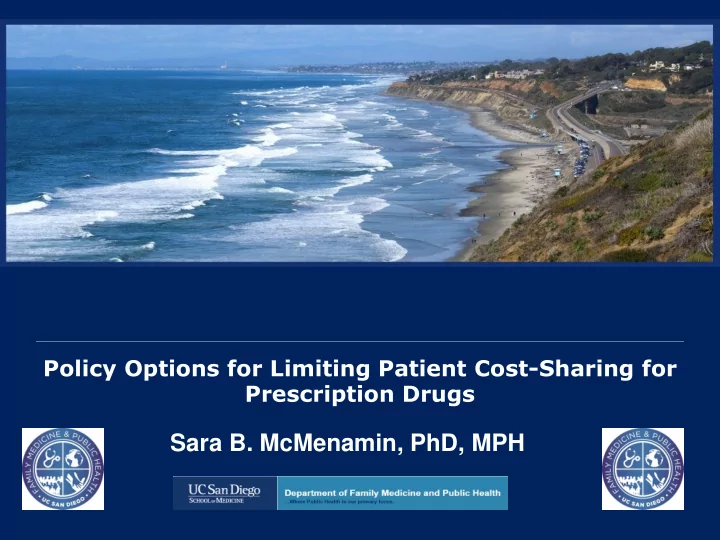

Policy Options for Limiting Patient Cost-Sharing for Prescription Drugs Sara B. McMenamin, PhD, MPH
Acknowledgements • Co-Authors • Riti Shimkhada, PhD, MPH • Ninez Ponce, PhD MPP • Garen Corbett, MS • California Health Benefits Review Program
California Health Benefits Review Program (CHBRP) • Legislatively established • Analyze legislation per request of the assembly/senate health committees related to insurance benefits • Staffed with central staff at UCOP; researchers at UCSD, UCLA, UCSF, and UC Davis; and actuarial firm (PWC) • Funded through a health plan tax • 60 day timeline • Address Effectiveness, Cost, and Public Health Impacts
Objective Present results from 4 CHBRP analyses of policy options to reduce patient cost-sharing in California: AB 310 (2011) • AB 1800 (2012) • AB 1917 (2014) • AB 339 (2015) •
Methods CHBRP analyzed 4 bills during 2011-2015 • related to patient OOP for drugs CHBRP conducted surveys of California • health insurers to determine the current levels of coverage and cost-sharing for each analysis. Actuarial firm used claims database to • estimate utilization Population Studied: 11.1 -21.7 million • individuals with insurance in California subject to state regulation.
Policy Options 1. Prohibiting coinsurance cost-sharing for outpatient prescription drug benefits, 2. Limiting copayments to a specified dollar amount for a specified supply of medication, 3. Requiring drug benefit cost sharing to be included in the annual out-of-pocket maximum, 4. Prohibiting separate deductible for prescription drugs, 5. Prohibiting placing all or most of the medications used to treat a certain condition in the highest cost-sharing tier, and 6. Regulating the determination of placing drugs in the specialty tier.
Assembly Bill 310 (2011) Content • Prohibits coinsurance for prescription drugs, • Limits copayments to $150 per one month supply; • Drug cost sharing must be included in OOP max (no limit specified) • Applies to 21.7 million Californians Results • Baseline 67% of enrollees have non-compliant coverage • Reduction in average cost of Rx from $271 to $150 • Increase in drug utilization of 4.0% • $189 million decrease in enrollee OOP costs • No impact based on OOP max provision
Assembly Bill 1800 (2012) Content • Drug cost sharing must be included in OOP max Set OOP Max at $6,050/$12,500 • Prohibit separate deductible for prescription drugs • Applies to 21.7 million Californians Results • Baseline 64% of enrollees have non-compliant coverage • $276 million decrease in enrollee OOP costs • Average decrease in cost sharing of $213 • Decrease driven by cap on OOP Max
Assembly Bill 1917 (2014) Content • $265 Cap on cost-sharing per 30-day prescription (1/24 of annual OOP limit) • Applies to 11.7 million Californians • Excludes Medical MCOs and CalPers Results • $22 million decrease in enrollee OOP costs • Reduction in average cost of Rx from $325 to $189 • 3% Increase in drug utilization
Assembly Bill 339 (2015) Content (As Introduced) • Cost sharing for prescription drugs needs to be reasonable • Must cover single tablet multi-drug regimens unless it is proven to be more effective if taken individually • Must cover extended release drugs unless the non extended release equivalent is proven to be more effective • Drugs to treat a specific condition may not be placed in the highest cost tier • Department of Managed Health Care to define ”specialty” drugs
Assembly Bill 339 (2015) Content (As Amended) • Added $265 Cap on cost-sharing per 30-day prescription (1/24 of annual OOP limit) • Applies to 21.7 million Californians Results • Baseline 12% of enrollees have non-compliant coverage • $65 million decrease in enrollee OOP costs • No change modeled based on “reasonable” clause
Assembly Bill 339 (2015) Content (As Passed) • Drug formulary may not discriminate against or discourage enrollment of people with specific conditions; • Must cover single tablet combo drugs for HIV/AIDS, • $250 Cap on cost-sharing per 30-day prescription ($500 for bronze plans) Results • TBD
Implications As of January 1, 2016, there were 12 states who had enacted legislation to limit cost-sharing for prescription drugs.
Thank You! For more information on the California Health Benefits Review Program see www.chbrp.org
Recommend
More recommend